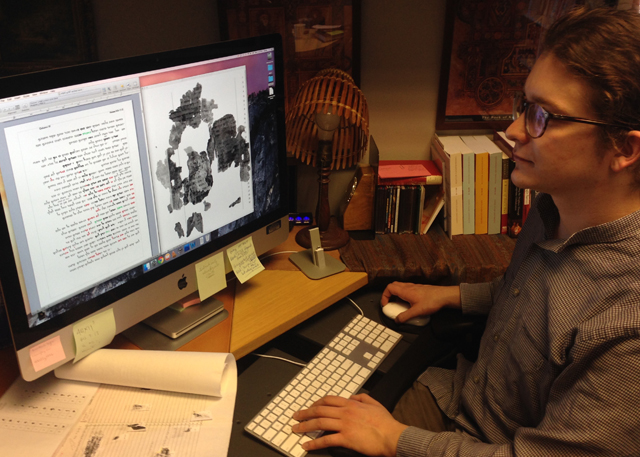
Piecing Together the Past: Collaborating to Rebuild a Biblical Manuscript
Jonathan Homrighausen (with contributions from Dr. Catherine Murphy)
When I first came to SCU, I had studied biblical Hebrew for a year under a rabbi. Since SCU doesn’t offer regular courses in Hebrew, Dr. Murphy took me under her wing, spending three quarters helping me with the language and eventually preparing me to take Advanced Hebrew at the GTU. Now, as the culmination of our work together, I am helping her put together a critical edition of a two-thousand-year-old manuscript of twelve prophetic books found among the Dead Sea Scrolls (4QXIIg). Even though it’s a relatively complete manuscript of these prophets (Hosea, Amos, Jonah, etc.), it’s so fragmentary and so hard to read that one of the first scholars to work on it called it the “dirty little XII” (or “the Dirty Dozen”). The inside of the scroll is still bound together, unable to be unwrapped without completely disintegrating!
Though Dr. Murphy worked on this manuscript while she was a doctoral student at Notre Dame, the timetable of publication did not allow the lead editor to identify all the fragments. They identified the easiest, largest fragments and left the rest for later. Our work has been focused on these tiny fragments, often containing only parts of several letters, written in the idiosyncratic script of a long-dead Essene scribe. We are also cataloguing new evidence of the manuscript that was missed in the first edition, along with new contents now visible through technologically enhanced photographic techniques.
Our work began with Dr. Murphy contacting the Israel Antiquities Authority, curators of the Dead Sea Scrolls, to order high-quality photos of the fragments. Many fragments have deteriorated to the point that their writing is invisible to the naked eye, and one can only see the contents with special kinds of light. Once she had the digital image of each fragment, Dr. Murphy located the fragment in the minor prophets based on later manuscripts of the Hebrew text and patterns of deterioration in the manuscript. At this point she has identified most of the fragments that can be identified. My work now is putting together her identified fragments into our partial reconstruction of the scroll.
As an undergraduate, it’s easy to feel like I can’t put my knowledge to good use for the world. This project has helped me use the skills from my three years of Hebrew to good use. I enjoy that greatly. But don’t get me wrong: textual criticism is frustrating: there’s a section of the scroll we cannot unroll (until better technology comes along!), there are fragments that remain unidentifiable, and we have found only minor spelling differences, not history-making variants. But most importantly, throughout our collaboration, Dr. Murphy has shown me a model of the kind of work that creates good scholarship: slow, careful, often unexciting but always thorough. I hope to carry this model into graduate school and my future life as an academic.
In February, Religious Studies major Jonathan Homrighausen gave a presentation on his research on Buddhist-Christian dual belonging. In his research, Homrighausen interviewed eight Christians who also converted to Buddhism to understand both their conversion process and how they navigated their dual identities. While Abrahamic faiths tend to see conversion as a process of replacing old beliefs with new ones, he argues that the conversion experience is more similar to speaking Spanglish. In January, Homrighausen received word from Thomas Cattoi at the Jesuit School of Theology that his research would be published in this fall's issue of Buddhist-Christian Studies, the premier peer-reviewed journal for Buddhist-Christian dialogue and scholarship. Homrighausen says that his talk to the department was a satisfying capstone to the whole process. He notes that the best part of the talk was the very lively discussion that followed. Homrighausen is grateful to David Gray and Sarita Tamayo-Moraga for their help on this project.